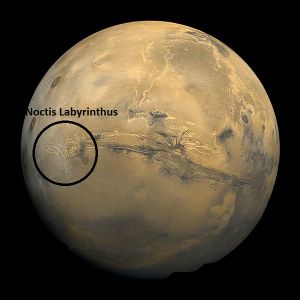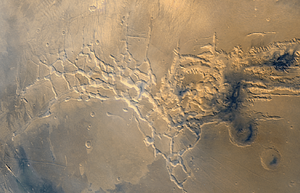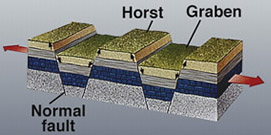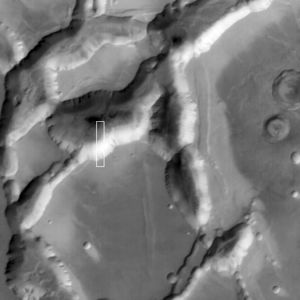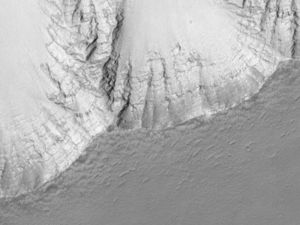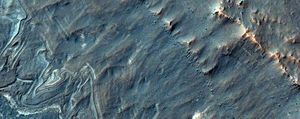Difference between revisions of "Noctis Labyrinthus"
(added info and ref) |
m (→Geology: Added a link.) |
||
| (55 intermediate revisions by 5 users not shown) | |||
| Line 1: | Line 1: | ||
| − | Noctis Labyrinthus is a group of intersecting canyons that lies at the western end of [[Valles Marineris]]. It is in the Phoenicis Laus quadrangle. The center coordinates of Noctis Labyrinthus are 7.0 S and 102.2 W. The canyons of this feature are faults known as grabens. Grabens happen when a center section drops lower than sections on either side. | + | {{Mars atlas}} |
| + | Noctis Labyrinthus is a group of intersecting canyons that lies at the western end of [[Valles Marineris]]. It is in the Phoenicis Laus quadrangle. The center coordinates of Noctis Labyrinthus are 7.0 S and 102.2 W (257.8 E). It has a diameter of 1190.31 km.<ref>https://planetarynames.wr.usgs.gov/SearchResults?target=MARS&featureType=Labyrinthus, labyrinthi</ref> The canyons of this feature are faults known as grabens. Grabens happen when a center section drops lower than sections on either side. | ||
| − | Discovered by Mariner 9, the name "Noctis Labyrinthus," means "the labyrinth of the night." | + | Discovered by Mariner 9, the name "Noctis Labyrinthus," means "the labyrinth of the night." The name was approved in 1973.<ref>https://planetarynames.wr.usgs.gov/SearchResults?target=MARS&featureType=Labyrinthus, labyrinthi</ref> |
[[Image:Noctislabyrinthusviking1.jpg|thumb|left|px|Noctis Labyrinthus (circled) lies at the western end of Valles Marineris]] | [[Image:Noctislabyrinthusviking1.jpg|thumb|left|px|Noctis Labyrinthus (circled) lies at the western end of Valles Marineris]] | ||
[[Image: Noctis Labyrinthus Viking 1 1980.png|thumb|center|px|Noctis Labyrinthus]] | [[Image: Noctis Labyrinthus Viking 1 1980.png|thumb|center|px|Noctis Labyrinthus]] | ||
| + | |||
| + | ==Geology== | ||
| + | [[File: Horst_graben.jpg|thumb|top| Splitting crust forms mesas and canyons]] | ||
| + | |||
| + | At first the interlocking canyons of Noctis Labyrinthus were thought to be caused by erosion (and indeed erosion has occurred in them). But it is now clear that they are formed by faulting. | ||
| + | |||
| + | To the east is the Valles Marineris, a continent sized Rift Valley, which formed when two sections of the crust moved apart from each other. At this end, the crust split by a lesser amount. As the ground split, normal faults occurred. Some areas of crust remained high, others settled, creating a linked series canyons and mesas. | ||
| + | |||
| + | As liquid water flowed on Mars in its early history, the lower areas became eroded showing signs of these [[Rivers on Mars | ancient rivers]]. | ||
| + | |||
| + | ==General== | ||
| + | Many spacecraft have found a large number of layers exposed in craters, canyons, and various depressions. Noctis Labyrinthus displays many layers both in its walls and on floor deposits. Layers can be formed in many ways such as volcanic flows, volcanic eruptions, wind blown dust, and under bodies of water. Layers that break up into large boulders or blocks are thought to be formed from hard rock like basalt from the many volcanoes on the planet. In many places, however, the layers are seen to consist of fine particles. The wind often carries these small particles away in time. The fine particles are interesting; they could be made of clay which requires water for its formation. Indeed, spectroscopes onboard orbiting spacecraft like the Mars Reconnaissance orbiter have detected clay in some of the layers. | ||
| + | |||
| + | The idea that layers in Noctis Labyrinthus contain clay is exciting. It implies lots of water in the past. Life may have originated when some of these layers were put down. The water may have been under a lake, but it also may have come from the ground. Layers can be hardened by the action of groundwater, and thereby become more resistant to erosion. Martian ground water may have traveled hundreds of kilometers, and in the process dissolved many minerals from the rock it passed through. When ground water surfaces in low areas containing sediments, water evaporates in the thin atmosphere and leaves behind minerals as deposits and/or cementing agents. Hence, layers composed of just dust after being cemented could form a hard lyer that does not easily erode away. | ||
| + | |||
| + | The pictures below show some of the layers in Noctis Labyrinthus. The picture to the left below is a context image for Mars Global Surveyor. Part of the area under the rectangle is enlarged in the image below right. | ||
[[Image:Part of Noctis Labyrinthus taken with the Mars Global Surveyor - 20060529.jpg|thumb|left|px|Context image of Noctis Labyrinthus]] | [[Image:Part of Noctis Labyrinthus taken with the Mars Global Surveyor - 20060529.jpg|thumb|left|px|Context image of Noctis Labyrinthus]] | ||
| − | [[Image:Noctis Labyrinthusmgs.jpg |thumb|center|px|Close view of Noctis Labyrinthus]] | + | [[Image:Noctis Labyrinthusmgs.jpg |thumb|center|px|Close view of Noctis Labyrinthus This is an enlargement of the area in the box in the image to the left.]] |
| + | |||
| + | Research from 2009 found a variety of minerals, including clays, sulfates, and hydrated silicas, in some of the layers.<ref>http://www.sciencedaily.com/releases/2009/12//091216205910.htm |title=Trough deposits on Mars point to complex hydrologic past |publisher=Sciencedaily.com |date=2009-12-17 |accessdate=2013-07-16 |deadurl=yes |archiveurl=https://web.archive.org/web/20131018010626/http://www.sciencedaily.com/releases/2009/12//091216205910.htm |archivedate=2013-10-18 |df= }}</ref> These minerals are associated with water. The water may have been from a body of water or may have come from groundwater. Since water had to be involved in their formation, evidence of ancient or existing life may be found there. On the Earth the hardness of many sedimentary rocks, like sandstone, is largely caused by the cement it contains. | ||
| + | |||
| + | |||
| + | [[Image:Noctislabyrinthus49297 1715layersclosenorth.jpg |thumb|right|px|Close view of Noctis Labyrinthus with HiRISE]] | ||
| + | |||
| + | The picture on the left shows a close, color view of layered material found on the floor of Noctis Labyrinthus with HiRISE. These layers may have formed by groundwater or under a lake that was once in this region. The picture on the right is of layers near the top of Noctis Labyrinthus. HiRISE reveals many layers. The ones that contain large boulders probably were deposited as lava flows of basalt. | ||
| + | |||
| + | [[Image: NoctislabESP 027592 1685close.jpg |thumb|center|px|Close view of layers on floor of Noctis Labyrinthus with HiRISE]] | ||
| + | |||
| + | ===References:=== | ||
| + | <references/> | ||
| + | |||
| + | ==See Also== | ||
| + | |||
| + | * [[Geography of Mars]] | ||
| + | |||
| + | * [[High Resolution Imaging Science Experiment (HiRISE)]] | ||
| + | |||
| + | *[[Layers on Mars]] | ||
| + | |||
| + | *[[Phoenicis Lacus quadrangle]] | ||
| + | |||
| + | ==External links== | ||
| − | + | *[https://www.youtube.com/watch?v=RYG-HLr33CM Martian Geology - Jim Secosky - 16th Annual International Mars Society Convention] | |
| − | + | ==Further reading== | |
| − | + | * Grotzinger, J. and R. Milliken (eds.). 2012. ''Sedimentary Geology of Mars''. SEPM. | |
Latest revision as of 23:21, 27 October 2024
Noctis Labyrinthus is a group of intersecting canyons that lies at the western end of Valles Marineris. It is in the Phoenicis Laus quadrangle. The center coordinates of Noctis Labyrinthus are 7.0 S and 102.2 W (257.8 E). It has a diameter of 1190.31 km.[1] The canyons of this feature are faults known as grabens. Grabens happen when a center section drops lower than sections on either side.
Discovered by Mariner 9, the name "Noctis Labyrinthus," means "the labyrinth of the night." The name was approved in 1973.[2]
Geology
At first the interlocking canyons of Noctis Labyrinthus were thought to be caused by erosion (and indeed erosion has occurred in them). But it is now clear that they are formed by faulting.
To the east is the Valles Marineris, a continent sized Rift Valley, which formed when two sections of the crust moved apart from each other. At this end, the crust split by a lesser amount. As the ground split, normal faults occurred. Some areas of crust remained high, others settled, creating a linked series canyons and mesas.
As liquid water flowed on Mars in its early history, the lower areas became eroded showing signs of these ancient rivers.
General
Many spacecraft have found a large number of layers exposed in craters, canyons, and various depressions. Noctis Labyrinthus displays many layers both in its walls and on floor deposits. Layers can be formed in many ways such as volcanic flows, volcanic eruptions, wind blown dust, and under bodies of water. Layers that break up into large boulders or blocks are thought to be formed from hard rock like basalt from the many volcanoes on the planet. In many places, however, the layers are seen to consist of fine particles. The wind often carries these small particles away in time. The fine particles are interesting; they could be made of clay which requires water for its formation. Indeed, spectroscopes onboard orbiting spacecraft like the Mars Reconnaissance orbiter have detected clay in some of the layers.
The idea that layers in Noctis Labyrinthus contain clay is exciting. It implies lots of water in the past. Life may have originated when some of these layers were put down. The water may have been under a lake, but it also may have come from the ground. Layers can be hardened by the action of groundwater, and thereby become more resistant to erosion. Martian ground water may have traveled hundreds of kilometers, and in the process dissolved many minerals from the rock it passed through. When ground water surfaces in low areas containing sediments, water evaporates in the thin atmosphere and leaves behind minerals as deposits and/or cementing agents. Hence, layers composed of just dust after being cemented could form a hard lyer that does not easily erode away.
The pictures below show some of the layers in Noctis Labyrinthus. The picture to the left below is a context image for Mars Global Surveyor. Part of the area under the rectangle is enlarged in the image below right.
Research from 2009 found a variety of minerals, including clays, sulfates, and hydrated silicas, in some of the layers.[3] These minerals are associated with water. The water may have been from a body of water or may have come from groundwater. Since water had to be involved in their formation, evidence of ancient or existing life may be found there. On the Earth the hardness of many sedimentary rocks, like sandstone, is largely caused by the cement it contains.
The picture on the left shows a close, color view of layered material found on the floor of Noctis Labyrinthus with HiRISE. These layers may have formed by groundwater or under a lake that was once in this region. The picture on the right is of layers near the top of Noctis Labyrinthus. HiRISE reveals many layers. The ones that contain large boulders probably were deposited as lava flows of basalt.
References:
- ↑ https://planetarynames.wr.usgs.gov/SearchResults?target=MARS&featureType=Labyrinthus, labyrinthi
- ↑ https://planetarynames.wr.usgs.gov/SearchResults?target=MARS&featureType=Labyrinthus, labyrinthi
- ↑ http://www.sciencedaily.com/releases/2009/12//091216205910.htm |title=Trough deposits on Mars point to complex hydrologic past |publisher=Sciencedaily.com |date=2009-12-17 |accessdate=2013-07-16 |deadurl=yes |archiveurl=https://web.archive.org/web/20131018010626/http://www.sciencedaily.com/releases/2009/12//091216205910.htm |archivedate=2013-10-18 |df= }}
See Also
External links
Further reading
- Grotzinger, J. and R. Milliken (eds.). 2012. Sedimentary Geology of Mars. SEPM.
